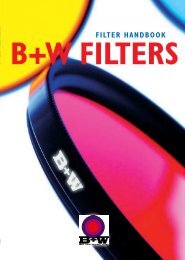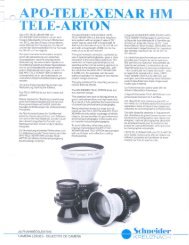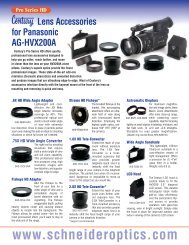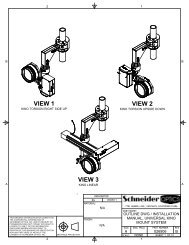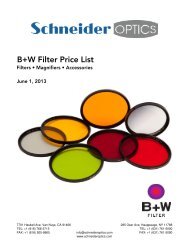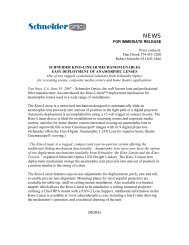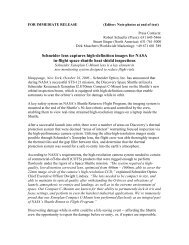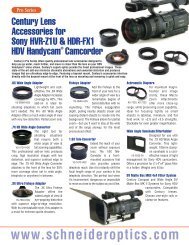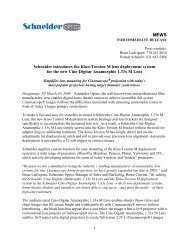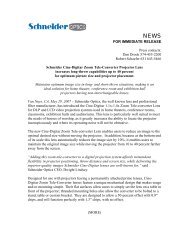History of Anamorphic Lenses - Schneider Optics
History of Anamorphic Lenses - Schneider Optics
History of Anamorphic Lenses - Schneider Optics
You also want an ePaper? Increase the reach of your titles
YUMPU automatically turns print PDFs into web optimized ePapers that Google loves.
<strong>History</strong> <strong>of</strong> <strong>Anamorphic</strong> <strong>Lenses</strong><br />
1926 - Pr<strong>of</strong>essor Henri Chrétien Chr tien<br />
applied for a patent on<br />
the “Hypergonar Hypergonar anamorphic<br />
lens system<br />
(he had developed the idea for tanks in WW I)<br />
1929 - First film was “Construire Construire un feu” feu The<br />
aspect ratio was 2.66:1<br />
1937 – He demonstrated it at the Paris World<br />
Fair on a 6,500 square foot screen<br />
�� 1926<br />
�� 1929<br />
�� 1937
The Chretien Patent<br />
�� Patent for:<br />
Combined Picture and<br />
Sound Recording and<br />
Projection in Motion<br />
Pictures
CINERAMA<br />
�� Used three synchronized 35mm projectors<br />
�� Deeply curved wide screen image<br />
�� 6 track magnetic sound
Cinemascope<br />
�� 1952 – 20 th Century Fox acquired the patent<br />
�� <strong>Lenses</strong> were made by Bauch & Lomb<br />
�� The 20 th Century Fox process for 35mm film<br />
was called “Cinemascope<br />
Cinemascope”
CINEMASCOPE Competitors<br />
• AgaScope (a form <strong>of</strong> CinemaScope from Sweden and Hungary)<br />
• AgaScope (a form <strong>of</strong> CinemaScope from Sweden and Hungary)<br />
• ArriScope (a form <strong>of</strong> CinemaScope from the Arriflex Camera Corp.)<br />
• ArriVision (2.35:1 in 3-D)<br />
• Cinepanoramic (a form <strong>of</strong> CinemaScope from France)<br />
• CinemaScope (some early titles were 2.66:1 and 2:55:1)<br />
• CinemaScope 55 (a form <strong>of</strong> CinemaScope using 55mm film)<br />
• Cinerama (2.6:1 to 2.8:1)<br />
• Cinescope (a form <strong>of</strong> CinemaScope from Italy)<br />
• Colorscope (various ratios used under this umbrella name)<br />
• Cromoscope (a form <strong>of</strong> Techniscope)<br />
• Daiescope (a form <strong>of</strong> CinemaScope from Japan)<br />
• Dimension 150 (2.2:1)<br />
• Duo-Vision (2.35:1 in split-screen)<br />
• Dyaliscope (a form <strong>of</strong> CinemaScope from France)<br />
• Euroscope (a form <strong>of</strong> CinemaScope)<br />
• Franscope (a form <strong>of</strong> CinemaScope from France)<br />
• Grandeur (2:1 approximately)<br />
• Grandscope (a form <strong>of</strong> CinemaScope from Japan)<br />
• Hammerscope (a form <strong>of</strong> CinemaScope from England)<br />
• J-D-C Scope<br />
• Megascope (a form <strong>of</strong> CinemaScope from England)<br />
• Metroscope (1.66:1 to 2:1)<br />
• MGM Camera 65 (2.75:1)<br />
• Natural Vision (2:1 approximately)<br />
• Naturama (a form <strong>of</strong> CinemaScope)<br />
• Nikkatsu Scope (a form <strong>of</strong> CinemaScope from Japan)<br />
• Panascope (2:1)<br />
• Panavision (pre-1971: 2.35:1 / post-1971: 2.4:1)<br />
• Panavision Super 70 (2.35:1 for 35mm prints, 2.2:1 for 70mm)<br />
• Panoramic(a) (a form <strong>of</strong> CinemaScope form Italy)<br />
• Sc• Realife (2.1 approximately)<br />
• Regalscope (a form <strong>of</strong> CinemaScope)<br />
• RKO-Scanoscope (a form <strong>of</strong> CinemaScope)<br />
• Shawscope (a form <strong>of</strong> CinemaScope from Hong Kong)<br />
• Sovscope (a form <strong>of</strong> CinemaScope from the U.S.S.R.)<br />
• Space-Vision (2.35:1 in 3-D)<br />
• Spectrascope (a form <strong>of</strong> CinemaScope)<br />
• Superama (a form <strong>of</strong> Superscope 235)<br />
• SuperCinescope (a form <strong>of</strong> CinemaScope from Italy)<br />
• Superpanorama 70 (2.2:1 in 70mm; a form <strong>of</strong> Todd-AO from Europe)<br />
• Super Panavision 70 (2.35 for 35mm prints; 2.2:1 for 70mm)<br />
• Superscope (2:1)<br />
• Superscope 235<br />
• Super Technirama 70 (2.2:1 in 70mm)<br />
• Super Techniscope (1.85:1 to 2.35:1; a variable process - same as Super<br />
35)<br />
• Super 35 (1.85:1 to 2.35:1; a variable screen-size process)<br />
• SuperTotalscope (a form <strong>of</strong> CinemaScope from Italy)<br />
• System 35 (1.85:1 to 2:35:1; a variable process - same as Super 35)<br />
• Technirama<br />
• Techniscope<br />
• Technovision<br />
• Todd-AO (2.2:1)<br />
• Todd-AO 35<br />
• Toeiscope (a form <strong>of</strong> CinemaScope from Japan)<br />
• Tohoscope (a form <strong>of</strong> CinemaScope from Japan)<br />
• Totalscope (a form <strong>of</strong> CinemaScope from Italy)<br />
• Totalvision (a form <strong>of</strong> CinemaScope from Italy)<br />
• Ultra Panavision 70 (2.75:1)<br />
• Ultrascope (a form <strong>of</strong> CinemaScope from Germany)<br />
• Vistarama (a form <strong>of</strong> CinemaScope)<br />
• Vistascope (a form <strong>of</strong> Superscope)<br />
• VistaVision (ranges from 1.66:2 to 2:1; a variable ratio)<br />
• Vitascope (2:1 approximately)<br />
• WarnerScope (a form <strong>of</strong> CinemaScope)<br />
• Warwickscope (a form <strong>of</strong> CinemaScope from England)
Two Types <strong>of</strong> <strong>Anamorphic</strong>s<br />
�� Cylindrical <strong>Anamorphic</strong><br />
System (<strong>Schneider</strong> Type)<br />
Focusable<br />
�� Prism <strong>Anamorphic</strong><br />
System (Panamorph ( Panamorph Type)<br />
Not Focusable
Cinemascope Camera <strong>Lenses</strong><br />
�� A 35mm Motion Picture Camera is equipped with a<br />
cylindrical lens (anamorphic lens) which squeezes the<br />
image horizontally 2 to 1 onto the film. These are <strong>of</strong>ten<br />
zoom lenses with built in anamorphic sections<br />
A cylindrical lens element –<br />
good anamorphic lenses have at<br />
least 4 <strong>of</strong> these lens elements<br />
Panavision anamorphic<br />
camera lenses<br />
“Filmed in Panavision”
<strong>Anamorphic</strong> Projection <strong>Lenses</strong><br />
for 35mm Film projection<br />
�� People are thinner on the film,<br />
cars are shorter by 2x.<br />
�� A cylindrical lens (anamorphic lens)<br />
is used on the 35mm film projector<br />
to unsqueeze the image<br />
�� The aspect ratio on the screen is 2.39:1<br />
common usage is 2.35:1 2.4:1 is NOT correct
Aspect ratio (image)<br />
From Wikipedia<br />
The aspect ratio <strong>of</strong> an image is its displayed<br />
width divided by its height (usually<br />
expressed as “x:y” or “x×y,” with the<br />
joining colon or multiplication symbol<br />
articulated as the preposition “by” or<br />
sometimes “to”). For instance, the aspect<br />
ratio <strong>of</strong> a traditional television screen is 4:3,<br />
or 1.33:1.<br />
High-definition television and European<br />
digital television use an aspect <strong>of</strong> 16:9, or<br />
about 1.78:1. Aspect ratios <strong>of</strong> 2.39:1 or<br />
1.85:1 are frequently used in<br />
cinematography, while the aspect ratio <strong>of</strong> a<br />
sync-sound 35 mm film frame is 1.37:1 (also<br />
known as “Academy Aperture” ratio). Silent<br />
films, which used the full frame, were shot<br />
in 1.33:1.<br />
1.33:1<br />
1.78:1
Cinemascope<br />
Common Aspect Ratios<br />
High Definition 16x9 1.78:1<br />
1.78:1<br />
Widescreen 1.85:1 “Flat” 4x3 Standard Def Television
35mm Film Formats<br />
Optical<br />
sound<br />
track<br />
goes here<br />
Silent<br />
Academy<br />
1.85 Widescreen<br />
Cinemascope
2x Horizontal Expansion <strong>of</strong><br />
Cinemascope in Projector
Cinemascope Letterboxed on 16x9 Display<br />
Pixel Loss – Wasted Image Area<br />
�� 1080p image – 16x9 1.78:1<br />
1080 x 1920 = 2,073,600 pixels<br />
�� Letterboxed Cinemascope image – 2.35:1<br />
832 x 1920 = 1,597,440 pixels<br />
�� 33% <strong>of</strong> the pixels are WASTED!<br />
�� 33% <strong>of</strong> the brightness is wasted



